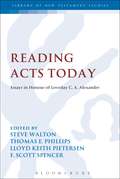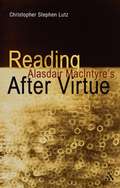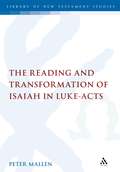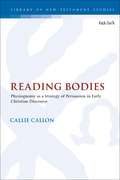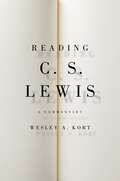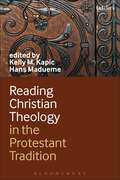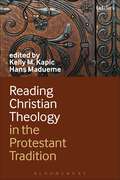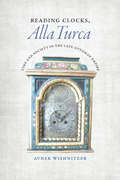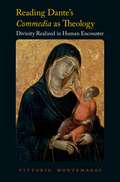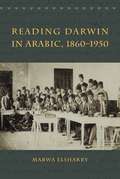- Table View
- List View
Reading Acts Today (The Library of New Testament Studies #427)
by Steve Walton Thomas E. Phillips Lloyd Keith Pietersen F. Scott SpencerReading Acts Today provides a 'state of the art' view of study of Acts from a variety of perspectives and approaches. It is a fresh and stimulating collection of scholarly essays at the cutting edge of the discipline. The contributions come at Acts from many different angles including historical, theological, socio-economic, literary, narrative, and exegetical approaches. This enables a thorough examination of the way that other ancient writings illuminate Acts and locates the book in its ancient context. The wide range of contributors features some of the most influential names in modern New Testament studies, providing a remarkable assessment of current scholarship on the book of Acts. These include James D.G. Dunn, I. Howard Marshal, and Richard Burridge. It was formerly the Journal for the Study of the New Testament Supplement, a book series that explores the many aspects of New Testament study including historical perspectives, social-scientific and literary theory, and theological, cultural and contextual approaches.
Reading Adorno: The Endless Road
by Amirhosein KhandizajiThis book draws on core concepts coined by Adorno, such as identity thinking, the culture industry, and his critique of the autonomous and rational subject, to address the ills that plague neoliberal capitalist societies today. These ills range from the risk of a return to totalitarian tendencies, to the global rise of the far-right, and anti-feminist conceptions of motherhood. Subsequent chapters outline the ways in which Adorno's thought can also be seen to redress the challenges of modern societies, such as the critical function of artworks, and the subversive potential of slow-food and popular music. The important underlying concern of the book is to highlight the continuing relevance of Adorno, both in dealing with the failures of neo-liberal capitalist societies, and in his applicability to a wide range of disciplines.
Reading Alasdair MacIntyre’s After Virtue
by Christopher Stephen LutzAfter Virtue is a watershed in MacIntyre's career. It follows his emergence from Marxism, but draws on Marxist sources and arguments. It precedes his move to Thomism, but already draws on Augustine and Aquinas. Because of its watershed nature, it has gained a wide readership in various fields but it treats a variety of issues in ways that are unfamiliar either to Marxists schooled in the social sciences or to Thomists schooled in medieval metaphysics.  Reading Alasdair MacIntyre's After Virtue provides a commentary that will be accessible to students, valuable to scholars, and useful to teachers. Students will find help to navigate the two main arguments of After Virtue, to understand its interpretation of history, and to engage its proposal for a form of ethics and politics that returns to the tradition of the virtues. Scholars will find the book useful as a general guide to MacIntyre's ethics. Teachers will find a book that can help to direct their students' reading and keep classroom discussions focused on the book's central concerns.
Reading Alasdair MacIntyre’s After Virtue
by Christopher Stephen LutzAfter Virtue is a watershed in MacIntyre's career. It follows his emergence from Marxism, but draws on Marxist sources and arguments. It precedes his move to Thomism, but already draws on Augustine and Aquinas. Because of its watershed nature, it has gained a wide readership in various fields but it treats a variety of issues in ways that are unfamiliar either to Marxists schooled in the social sciences or to Thomists schooled in medieval metaphysics. Reading Alasdair MacIntyre's After Virtue provides a commentary that will be accessible to students, valuable to scholars, and useful to teachers. Students will find help to navigate the two main arguments of After Virtue, to understand its interpretation of history, and to engage its proposal for a form of ethics and politics that returns to the tradition of the virtues. Scholars will find the book useful as a general guide to MacIntyre's ethics. Teachers will find a book that can help to direct their students' reading and keep classroom discussions focused on the book's central concerns.
The Reading and Transformation of Isaiah in Luke-Acts (The Library of New Testament Studies #367)
by Peter MallenAn investigative study into where, how and why Luke interacts with Isaiah. References to Isaiah occur at key points in the narrative, typically introducing the mission of main characters and outlining or summarising the overall plot, suggesting that Luke utilises Isaiah as part of his interpretive framework. The overarching theme drawn from Isaiah appears to be the servant's mission to bring salvation to all people (Isa 49:6). Luke's careful selection and radical interpretation of Isaianic texts highlights surprising aspects of this theme. These include the nature and scope of salvation, the necessary suffering role of the Messiah and its connection with the proclamation of salvation, and the unexpected response to the message by Israel and the nations. Mallen's study rehabilitates the importance of the servant motif for Luke, not in terms of atonement or as a christological title but rather in supplying the job description for Jesus' messianic mission and that of his followers.
Reading and Writing Scripture in New Religious Movements: New Bibles and New Revelations (Palgrave Studies in New Religions and Alternative Spiritualities)
by E. GallagherNew religious movements both read the Bible in creative ways and produce their own texts that aspire to scriptural status. From the creation stories in Genesis and the Ten Commandments to the life of Jesus and the apocalypse, they develop their self-understandings through reading and writing scripture.
Reading Anselm's Proslogion: The History of Anselm's Argument and its Significance Today (Routledge New Critical Thinking in Religion, Theology and Biblical Studies)
by Ian LoganAnselm’s Proslogion has sparked controversy from the time it was written (c.1077) to the present day. Attempts to provide definitive accounts of its argument have led to a wide and contradictory variety of interpretations. In this book, Ian Logan goes back to basics, to the Latin text of the Proslogion with an original parallel English translation, before tracing the twists and turns of this controversy. Helping us to understand how the same argument came to be regarded as based on reason alone by some and on faith alone by others, as a logically sound demonstration by its supporters and as fatally flawed by its opponents, Logan considers what Anselm is setting out to do in the Proslogion, how his argument works, and whether it is successful.
Reading Anselm's Proslogion: The History of Anselm's Argument and its Significance Today (Routledge New Critical Thinking in Religion, Theology and Biblical Studies)
by Ian LoganAnselm’s Proslogion has sparked controversy from the time it was written (c.1077) to the present day. Attempts to provide definitive accounts of its argument have led to a wide and contradictory variety of interpretations. In this book, Ian Logan goes back to basics, to the Latin text of the Proslogion with an original parallel English translation, before tracing the twists and turns of this controversy. Helping us to understand how the same argument came to be regarded as based on reason alone by some and on faith alone by others, as a logically sound demonstration by its supporters and as fatally flawed by its opponents, Logan considers what Anselm is setting out to do in the Proslogion, how his argument works, and whether it is successful.
Reading Bodies: Physiognomy as a Strategy of Persuasion in Early Christian Discourse (The Library of New Testament Studies)
by Callie CallonCallie Callon investigates how some early Christian authors utilized physiognomic thought as rhetorical strategy, particularly with respect to persuasion. Callon shows how this encompassed denigrating theological opponents and forging group boundaries (invective against heretics or defence of Christians), self-representation to demonstrate the moral superiority of early Christians to Greco-Roman outsiders, and the cultivation of collective self-identity.The work begins with an overview of how physiognomy was used in broader antiquity as a component of persuasion. Callon then examines how physiognomic thought was employed by early Christians and how physiognomic tropes were employed to “prove” their orthodoxy and moral superiority. Building on the conclusions of the earlier chapters, Callon then focuses on the representation of the physiognomies of early Christian martyrs, before addressing the problem of the acceptance or even promotion of the idea of a physically lacklustre Jesus by the same authors who otherwise utilize traditional physiognomic thought.
Reading Bodies: Physiognomy as a Strategy of Persuasion in Early Christian Discourse (The Library of New Testament Studies #597)
by Callie CallonCallie Callon investigates how some early Christian authors utilized physiognomic thought as rhetorical strategy, particularly with respect to persuasion. Callon shows how this encompassed denigrating theological opponents and forging group boundaries (invective against heretics or defence of Christians), self-representation to demonstrate the moral superiority of early Christians to Greco-Roman outsiders, and the cultivation of collective self-identity.The work begins with an overview of how physiognomy was used in broader antiquity as a component of persuasion. Callon then examines how physiognomic thought was employed by early Christians and how physiognomic tropes were employed to “prove” their orthodoxy and moral superiority. Building on the conclusions of the earlier chapters, Callon then focuses on the representation of the physiognomies of early Christian martyrs, before addressing the problem of the acceptance or even promotion of the idea of a physically lacklustre Jesus by the same authors who otherwise utilize traditional physiognomic thought.
Reading C.S. Lewis: A Commentary
by Wesley A. KortFrom the unbending belief in invisible powers that animates Till We Have Faces to the depiction of Aslan's sacrifice and resurrection in The Lion, The Witch, and the Wardrobe, C. S. Lewis's writing has sparked intense debate about the presence and function of religion in his works. Today, a reader's opinion of Lewis is more often than not based on his or her perspectives on religion. In Reading C. S. Lewis, Wesley A. Kort examines Lewis's work as a whole, investigating why and at what points Lewis turns to religion-and particularly to Christianity-in order to advance his arguments. Kort moves through more than a dozen of Lewis's major books, providing a useful guide to their various elements while connecting readers to the literary contexts that influenced the works and Lewis himself. Reading C. S. Lewis examines the standing of Lewis's work, how best to approach the books, and the misunderstandings that lead to mistaken readings. The commentaries also function as free-standing essays that can be read individually and in any order. Reading C. S. Lewis: A Commentary sets a new standard for C. S. Lewis studies. A comprehensive examination of the major Lewis texts, this volume is a captivating look into the author's work from a refreshingly undogmatic point of view.
Reading C.S. Lewis: A Commentary
by Wesley A. KortFrom the unbending belief in invisible powers that animates Till We Have Faces to the depiction of Aslan's sacrifice and resurrection in The Lion, The Witch, and the Wardrobe, C. S. Lewis's writing has sparked intense debate about the presence and function of religion in his works. Today, a reader's opinion of Lewis is more often than not based on his or her perspectives on religion. In Reading C. S. Lewis, Wesley A. Kort examines Lewis's work as a whole, investigating why and at what points Lewis turns to religion-and particularly to Christianity-in order to advance his arguments. Kort moves through more than a dozen of Lewis's major books, providing a useful guide to their various elements while connecting readers to the literary contexts that influenced the works and Lewis himself. Reading C. S. Lewis examines the standing of Lewis's work, how best to approach the books, and the misunderstandings that lead to mistaken readings. The commentaries also function as free-standing essays that can be read individually and in any order. Reading C. S. Lewis: A Commentary sets a new standard for C. S. Lewis studies. A comprehensive examination of the major Lewis texts, this volume is a captivating look into the author's work from a refreshingly undogmatic point of view.
Reading Christian Scriptures in China
by Chloe StarrThis volume sets out to examine how Christian scriptures have been read within a Chinese reading tradition, and to assess what questions such readings pose for both theologians and Chinese studies specialists. The absence to date of publications on the topic, and the scattered nature of such research and of scholars in the field makes this an important contribution to debate. The volume gathers essays from Biblical studies experts together with theologians and Chinese text scholars to discuss the interdisciplinary questions raised. Essays from mainland, Taiwanese and diasporic Chinese scholars ensure that a range of opinions (including those reflecting fault lines between 'academic' and 'confessional' positions) are presented. Within the four sections of the volume, several papers discuss and correct the current lineage of historical readings, while others study the historical impact of the Bible in Chinese society. Four essays give contextual or cross-cultural readings, with a focus on individual exegetes, mainly from the early twentieth century. The power of performance is raised in two essays, one comparative paper on Christian and Buddhist scriptures from the Qing dynasty and one on the singing of psalms in modern day Taiwan and Macao. Moral questions preoccupy others, including the challenges that early Chinese converts found in Biblical laws or Christian guidance on concubinage, and extrincisist readings of the Sermon on the Mount.
Reading Christian Theology in the Protestant Tradition
by Dr Kelly Kapic Associate Professor Hans MaduemeReading Christian Theology in the Protestant Tradition offers a distinctive approach to the value of classic works through the lens of Protestantism. While it is anachronistic to speak of Christian theology prior to the Reformation as "Protestant”, it is wholly appropriate to recognize how certain common Protestant concerns can be discerned in the earliest traditions of Christianity. The resonances between the ages became both informative and inspiring for Protestants who looked back to pre-reformation sources for confirmation, challenge, and insight. Thus this book begins with the first Christian theologians, covering nearly 2000 years of theological writing from the Didache, Justin Martyr, and Origen to James Cone, José Míguez Bonino, and Sallie McFague. Five major periods of church history are represented in 12 key works, each carefully explained and interpreted by an expert in the field.
Reading Christian Theology in the Protestant Tradition
by Kelly Kapic Hans MaduemeReading Christian Theology in the Protestant Tradition offers a distinctive approach to the value of classic works through the lens of Protestantism. While it is anachronistic to speak of Christian theology prior to the Reformation as "Protestant†?, it is wholly appropriate to recognize how certain common Protestant concerns can be discerned in the earliest traditions of Christianity. The resonances between the ages became both informative and inspiring for Protestants who looked back to pre-reformation sources for confirmation, challenge, and insight. Thus this book begins with the first Christian theologians, covering nearly 2000 years of theological writing from the Didache, Justin Martyr, and Origen to James Cone, José Míguez Bonino, and Sallie McFague. Five major periods of church history are represented in 12 key works, each carefully explained and interpreted by an expert in the field.
Reading Clocks, Alla Turca: Time and Society in the Late Ottoman Empire
by Avner WishnitzerUp until the end of the eighteenth century, the way Ottomans used their clocks conformed to the inner logic of their own temporal culture. However, this began to change rather dramatically during the nineteenth century, as the Ottoman Empire was increasingly assimilated into the European-dominated global economy and the project of modern state building began to gather momentum. In Reading Clocks, Alla Turca, Avner Wishnitzer unravels the complexity of Ottoman temporal culture and for the first time tells the story of its transformation. He explains that in their attempt to attain better surveillance capabilities and higher levels of regularity and efficiency, various organs of the reforming Ottoman state developed elaborate temporal constructs in which clocks played an increasingly important role. As the reform movement spread beyond the government apparatus, emerging groups of officers, bureaucrats, and urban professionals incorporated novel time-related ideas, values, and behaviors into their self-consciously “modern” outlook and lifestyle. Acculturated in the highly regimented environment of schools and barracks, they came to identify efficiency and temporal regularity with progress and the former temporal patterns with the old political order. Drawing on a wealth of archival and literary sources, Wishnitzer’s original and highly important work presents the shifting culture of time as an arena in which Ottoman social groups competed for legitimacy and a medium through which the very concept of modernity was defined. Reading Clocks, Alla Turca breaks new ground in the study of the Middle East and presents us with a new understanding of the relationship between time and modernity.
Reading Clocks, Alla Turca: Time and Society in the Late Ottoman Empire
by Avner WishnitzerUp until the end of the eighteenth century, the way Ottomans used their clocks conformed to the inner logic of their own temporal culture. However, this began to change rather dramatically during the nineteenth century, as the Ottoman Empire was increasingly assimilated into the European-dominated global economy and the project of modern state building began to gather momentum. In Reading Clocks, Alla Turca, Avner Wishnitzer unravels the complexity of Ottoman temporal culture and for the first time tells the story of its transformation. He explains that in their attempt to attain better surveillance capabilities and higher levels of regularity and efficiency, various organs of the reforming Ottoman state developed elaborate temporal constructs in which clocks played an increasingly important role. As the reform movement spread beyond the government apparatus, emerging groups of officers, bureaucrats, and urban professionals incorporated novel time-related ideas, values, and behaviors into their self-consciously “modern” outlook and lifestyle. Acculturated in the highly regimented environment of schools and barracks, they came to identify efficiency and temporal regularity with progress and the former temporal patterns with the old political order. Drawing on a wealth of archival and literary sources, Wishnitzer’s original and highly important work presents the shifting culture of time as an arena in which Ottoman social groups competed for legitimacy and a medium through which the very concept of modernity was defined. Reading Clocks, Alla Turca breaks new ground in the study of the Middle East and presents us with a new understanding of the relationship between time and modernity.
Reading Clocks, Alla Turca: Time and Society in the Late Ottoman Empire
by Avner WishnitzerUp until the end of the eighteenth century, the way Ottomans used their clocks conformed to the inner logic of their own temporal culture. However, this began to change rather dramatically during the nineteenth century, as the Ottoman Empire was increasingly assimilated into the European-dominated global economy and the project of modern state building began to gather momentum. In Reading Clocks, Alla Turca, Avner Wishnitzer unravels the complexity of Ottoman temporal culture and for the first time tells the story of its transformation. He explains that in their attempt to attain better surveillance capabilities and higher levels of regularity and efficiency, various organs of the reforming Ottoman state developed elaborate temporal constructs in which clocks played an increasingly important role. As the reform movement spread beyond the government apparatus, emerging groups of officers, bureaucrats, and urban professionals incorporated novel time-related ideas, values, and behaviors into their self-consciously “modern” outlook and lifestyle. Acculturated in the highly regimented environment of schools and barracks, they came to identify efficiency and temporal regularity with progress and the former temporal patterns with the old political order. Drawing on a wealth of archival and literary sources, Wishnitzer’s original and highly important work presents the shifting culture of time as an arena in which Ottoman social groups competed for legitimacy and a medium through which the very concept of modernity was defined. Reading Clocks, Alla Turca breaks new ground in the study of the Middle East and presents us with a new understanding of the relationship between time and modernity.
Reading Clocks, Alla Turca: Time and Society in the Late Ottoman Empire
by Avner WishnitzerUp until the end of the eighteenth century, the way Ottomans used their clocks conformed to the inner logic of their own temporal culture. However, this began to change rather dramatically during the nineteenth century, as the Ottoman Empire was increasingly assimilated into the European-dominated global economy and the project of modern state building began to gather momentum. In Reading Clocks, Alla Turca, Avner Wishnitzer unravels the complexity of Ottoman temporal culture and for the first time tells the story of its transformation. He explains that in their attempt to attain better surveillance capabilities and higher levels of regularity and efficiency, various organs of the reforming Ottoman state developed elaborate temporal constructs in which clocks played an increasingly important role. As the reform movement spread beyond the government apparatus, emerging groups of officers, bureaucrats, and urban professionals incorporated novel time-related ideas, values, and behaviors into their self-consciously “modern” outlook and lifestyle. Acculturated in the highly regimented environment of schools and barracks, they came to identify efficiency and temporal regularity with progress and the former temporal patterns with the old political order. Drawing on a wealth of archival and literary sources, Wishnitzer’s original and highly important work presents the shifting culture of time as an arena in which Ottoman social groups competed for legitimacy and a medium through which the very concept of modernity was defined. Reading Clocks, Alla Turca breaks new ground in the study of the Middle East and presents us with a new understanding of the relationship between time and modernity.
Reading Dante's Commedia as Theology: Divinity Realized in Human Encounter
by Vittorio MontemaggiDante's Commedia compels readers to confront the mystery of their existence, to seek understanding of their relationship to the living conscious reality from which all possible experience arises. By pursuing these lines of inquiry, says Vittorio Montemaggi, readers can reach an ultimate reality that Dante calls love. Montemaggi offers a detailed theological reading of the Commedia, examining the theme of human interaction, both as it is represented in the poem-the narrator Dante's interaction with other characters-and by the relationship between author and reader. In doing so, he locates a Dante we may not be used to imagining, a man aware both of the spiritual power of his work, and of his profound, essential vulnerability and moral failing. Montemaggi shows that, for this Dante, truth emerges only through human limitation and failure, and not in spite of it. Applying this interpretive framework to a reflection on the methodology of scholarship itself, Montemaggi offers a vision of what the academy could be-not individual scholars in competition with others, but a community that seeks to foster the understanding that can arise through interaction, vulnerability, and love. His vision constitutes a benign challenge to some of the ethos and practices of the modern academy, while simultaneously reflecting on the dynamics of one of the most inspiring and influential texts ever written about the relationship between humanity and divinity.
Reading Dante's Commedia as Theology: Divinity Realized in Human Encounter
by Vittorio MontemaggiDante's Commedia compels readers to confront the mystery of their existence, to seek understanding of their relationship to the living conscious reality from which all possible experience arises. By pursuing these lines of inquiry, says Vittorio Montemaggi, readers can reach an ultimate reality that Dante calls love. Montemaggi offers a detailed theological reading of the Commedia, examining the theme of human interaction, both as it is represented in the poem-the narrator Dante's interaction with other characters-and by the relationship between author and reader. In doing so, he locates a Dante we may not be used to imagining, a man aware both of the spiritual power of his work, and of his profound, essential vulnerability and moral failing. Montemaggi shows that, for this Dante, truth emerges only through human limitation and failure, and not in spite of it. Applying this interpretive framework to a reflection on the methodology of scholarship itself, Montemaggi offers a vision of what the academy could be-not individual scholars in competition with others, but a community that seeks to foster the understanding that can arise through interaction, vulnerability, and love. His vision constitutes a benign challenge to some of the ethos and practices of the modern academy, while simultaneously reflecting on the dynamics of one of the most inspiring and influential texts ever written about the relationship between humanity and divinity.
Reading Darwin in Arabic, 1860-1950
by Marwa ElshakryIn Reading Darwin in Arabic, Marwa Elshakry questions current ideas about Islam, science, and secularism by exploring the ways in which Darwin was read in Arabic from the late 1860s to the mid-twentieth century. Borrowing from translation and reading studies and weaving together the history of science with intellectual history, she explores Darwin’s global appeal from the perspective of several generations of Arabic readers and shows how Darwin’s writings helped alter the social and epistemological landscape of the Arab learned classes. Providing a close textual, political, and institutional analysis of the tremendous interest in Darwin’s ideas and other works on evolution, Elshakry shows how, in an age of massive regional and international political upheaval, these readings were suffused with the anxieties of empire and civilizational decline. The politics of evolution infiltrated Arabic discussions of pedagogy, progress, and the very sense of history. They also led to a literary and conceptual transformation of notions of science and religion themselves. Darwin thus became a vehicle for discussing scriptural exegesis, the conditions of belief, and cosmological views more broadly. The book also acquaints readers with Muslim and Christian intellectuals, bureaucrats, and theologians, and concludes by exploring Darwin’s waning influence on public and intellectual life in the Arab world after World War I. Reading Darwin in Arabic is an engaging and powerfully argued reconceptualization of the intellectual and political history of the Middle East.
Reading Darwin in Arabic, 1860-1950
by Marwa ElshakryIn Reading Darwin in Arabic, Marwa Elshakry questions current ideas about Islam, science, and secularism by exploring the ways in which Darwin was read in Arabic from the late 1860s to the mid-twentieth century. Borrowing from translation and reading studies and weaving together the history of science with intellectual history, she explores Darwin’s global appeal from the perspective of several generations of Arabic readers and shows how Darwin’s writings helped alter the social and epistemological landscape of the Arab learned classes. Providing a close textual, political, and institutional analysis of the tremendous interest in Darwin’s ideas and other works on evolution, Elshakry shows how, in an age of massive regional and international political upheaval, these readings were suffused with the anxieties of empire and civilizational decline. The politics of evolution infiltrated Arabic discussions of pedagogy, progress, and the very sense of history. They also led to a literary and conceptual transformation of notions of science and religion themselves. Darwin thus became a vehicle for discussing scriptural exegesis, the conditions of belief, and cosmological views more broadly. The book also acquaints readers with Muslim and Christian intellectuals, bureaucrats, and theologians, and concludes by exploring Darwin’s waning influence on public and intellectual life in the Arab world after World War I. Reading Darwin in Arabic is an engaging and powerfully argued reconceptualization of the intellectual and political history of the Middle East.
Reading Darwin in Arabic, 1860-1950
by Marwa ElshakryIn Reading Darwin in Arabic, Marwa Elshakry questions current ideas about Islam, science, and secularism by exploring the ways in which Darwin was read in Arabic from the late 1860s to the mid-twentieth century. Borrowing from translation and reading studies and weaving together the history of science with intellectual history, she explores Darwin’s global appeal from the perspective of several generations of Arabic readers and shows how Darwin’s writings helped alter the social and epistemological landscape of the Arab learned classes. Providing a close textual, political, and institutional analysis of the tremendous interest in Darwin’s ideas and other works on evolution, Elshakry shows how, in an age of massive regional and international political upheaval, these readings were suffused with the anxieties of empire and civilizational decline. The politics of evolution infiltrated Arabic discussions of pedagogy, progress, and the very sense of history. They also led to a literary and conceptual transformation of notions of science and religion themselves. Darwin thus became a vehicle for discussing scriptural exegesis, the conditions of belief, and cosmological views more broadly. The book also acquaints readers with Muslim and Christian intellectuals, bureaucrats, and theologians, and concludes by exploring Darwin’s waning influence on public and intellectual life in the Arab world after World War I. Reading Darwin in Arabic is an engaging and powerfully argued reconceptualization of the intellectual and political history of the Middle East.
Reading Darwin in Arabic, 1860-1950
by Marwa ElshakryIn Reading Darwin in Arabic, Marwa Elshakry questions current ideas about Islam, science, and secularism by exploring the ways in which Darwin was read in Arabic from the late 1860s to the mid-twentieth century. Borrowing from translation and reading studies and weaving together the history of science with intellectual history, she explores Darwin’s global appeal from the perspective of several generations of Arabic readers and shows how Darwin’s writings helped alter the social and epistemological landscape of the Arab learned classes. Providing a close textual, political, and institutional analysis of the tremendous interest in Darwin’s ideas and other works on evolution, Elshakry shows how, in an age of massive regional and international political upheaval, these readings were suffused with the anxieties of empire and civilizational decline. The politics of evolution infiltrated Arabic discussions of pedagogy, progress, and the very sense of history. They also led to a literary and conceptual transformation of notions of science and religion themselves. Darwin thus became a vehicle for discussing scriptural exegesis, the conditions of belief, and cosmological views more broadly. The book also acquaints readers with Muslim and Christian intellectuals, bureaucrats, and theologians, and concludes by exploring Darwin’s waning influence on public and intellectual life in the Arab world after World War I. Reading Darwin in Arabic is an engaging and powerfully argued reconceptualization of the intellectual and political history of the Middle East.
